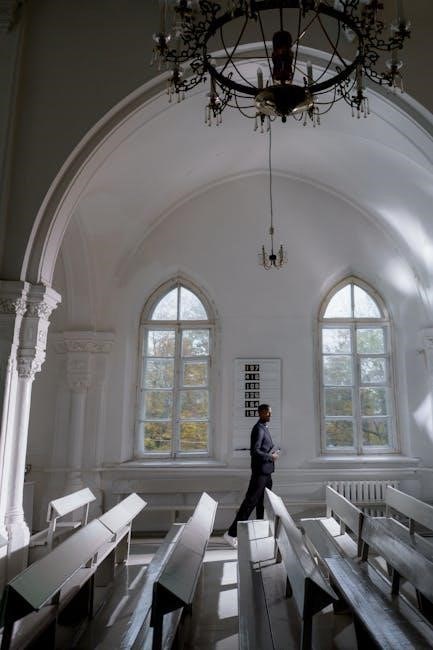The 2024 Liturgical Calendar provides a structured framework for worship, spiritual reflection, and communal celebration. It guides followers through sacred seasons, feasts, and solemnities, aligning with the Revised Common Lectionary. This calendar reflects the cyclical nature of the Church year, emphasizing key events and traditions;
Overview of the Liturgical Year 2024
The 2024 Liturgical Year begins on the First Sunday of Advent, December 3, 2023, and concludes on November 30, 2024. It is structured around the life of Christ and the Church, with seasons such as Advent, Christmas, Lent, Easter, and Ordinary Time. Key feasts include the Epiphany, Ash Wednesday, Easter Sunday, and Pentecost. The year aligns with the Revised Common Lectionary, providing readings for Sundays and weekdays. This calendar serves as a guide for worship, prayer, and spiritual reflection, helping communities connect with the global Church. It is available in printable PDF formats, making it accessible for personal or congregational use. The liturgical year emphasizes the cyclical nature of faith, inviting believers to deepen their relationship with God through structured observances and celebrations.
Key Features of the 2024 Liturgical Calendar
The 2024 Liturgical Calendar is a comprehensive guide that outlines the sacred seasons, feast days, and holy observances for the year. It includes detailed listings of solemnities, Sundays, and weekdays, following the Revised Common Lectionary. The calendar is structured to reflect the Church’s liturgical colors, enhancing worship experiences. Printable PDF versions are available, offering convenience for personal or congregational use. Customizable templates allow for tailored planning, while links to educational resources provide deeper understanding of liturgical practices. The calendar also highlights moveable feasts and Holy Days of Obligation, ensuring followers stay informed about significant dates. Its design promotes spiritual growth and communal celebration, making it an essential tool for aligning daily life with the Church’s liturgical rhythm.

Important Dates in the 2024 Liturgical Calendar
Key dates include the First Sunday of Advent on December 3, 2023, Christmas on December 25, 2023, and Easter Sunday on March 31, 2024. These mark pivotal liturgical celebrations.
Major Feasts and Solemnities in 2024
The 2024 liturgical calendar highlights several significant feasts and solemnities. On January 1, 2024, the Solemnity of Mary, the Holy Mother of God, is celebrated. The Epiphany of the Lord, traditionally on January 6, is transferred to January 7, 2024, in many U.S. dioceses. Easter Sunday falls on March 31, 2024, marking the resurrection of Christ; The Ascension of the Lord is on May 16, 2024, and Pentecost follows on May 23, 2024. These dates are central to the liturgical year, guiding worship and reflection. The calendar also includes other key feasts, such as the Nativity of John the Baptist and the Assumption of the Blessed Virgin Mary, enriching the spiritual journey throughout 2024.
Liturgical Seasons in 2024
The 2024 liturgical year is divided into distinct seasons, each carrying unique spiritual significance. It begins with Advent on December 3, 2023, a period of preparation for Christmas, and concludes on November 30, 2024. The Christmas Season follows, celebrating the birth of Christ, ending with the Baptism of the Lord. Lent, a 40-day period of reflection and penance, starts on February 14, 2024, leading to Easter on March 31, 2024. The Easter Season extends to Pentecost on May 23, 2024. The remaining part of the year is Ordinary Time, divided into two segments, focusing on the teachings of Jesus and the Church’s mission. These seasons provide a structured framework for worship, prayer, and spiritual growth throughout the year.
Moveable Feasts in the 2024 Liturgical Calendar
Moveable feasts in the 2024 liturgical calendar are celebrations whose dates vary annually based on the lunar cycle and other liturgical considerations. Key moveable feasts include Easter, which falls on March 31, 2024, determining the dates of Ash Wednesday on February 14, 2024, and Pentecost on May 23, 2024. Other notable moveable feasts are Ascension Day, celebrated on May 9, 2024, and the Epiphany, observed on January 6, 2024, though often transferred to the following Sunday in some regions. These feasts are integral to the liturgical structure, ensuring a dynamic and flexible framework for worship and reflection throughout the year.

Structure of the Liturgical Calendar 2024
The 2024 liturgical year begins on December 3, 2023 (First Sunday of Advent) and concludes on November 30, 2024. It includes Advent, Christmas, Lent, Easter, and Ordinary Time, with key feast days like January 1 (Mary, Mother of God) and January 6 (Epiphany).

Advent 2023-2024
The 2024 liturgical year begins with Advent 2023, starting on December 3, 2023, and concluding on December 24, 2023. Advent is a season of preparation and anticipation, marking the four Sundays leading up to Christmas. It emphasizes prayer, reflection, and spiritual readiness for the coming of Christ. The season is symbolized by the Advent wreath, with its progressive lighting of candles, representing hope, peace, joy, and love. The 2024 PDF liturgical calendar highlights Advent’s significance, featuring its traditional purple and rose colors. This period is a vital part of the Church’s cycle, guiding believers to focus on the true meaning of Christmas and the renewal of faith. The printable calendar provides a clear outline of Advent’s structure, making it easier for individuals and communities to engage deeply with its spiritual practices and traditions.
Christmas Season 2023-2024
The Christmas Season in the 2024 liturgical calendar begins on December 25, 2023, and extends through January 7, 2024, encompassing the Solemnity of Mary, Mother of God. This joyous period celebrates the birth of Jesus Christ and the Epiphany, highlighting key feast days. The PDF calendar features white as the liturgical color, symbolizing purity and celebration. It includes detailed dates for Christmas Day, the Epiphany, and other significant events, providing a clear and organized guide for worship and reflection. The printable format allows for easy planning and participation in the liturgical celebrations, ensuring a meaningful and spiritually enriching Christmas Season for individuals and communities alike.
Lent and Easter 2024
Lent in 2024 begins on February 14 (Ash Wednesday) and concludes on March 30 (Holy Saturday), culminating in Easter Sunday on March 31, 2024. This period of reflection and renewal is marked by prayer, fasting, and penance. The 2024 liturgical calendar highlights Lenten observances, including the Stations of the Cross and the Passion Narrative. Easter, the Resurrection of Christ, is celebrated with vibrant liturgical colors and joyous ceremonies. The PDF calendar provides detailed readings and reflections for each day, aligning with the Revised Common Lectionary. It also features the Easter Triduum—Holy Thursday, Good Friday, and Easter Vigil—as pivotal moments in the liturgical year. The printable format allows communities to plan and participate fully in these sacred celebrations, enriching their spiritual journey through Lent and Easter.
Ordinary Time 2024
Ordinary Time in 2024 is divided into two parts: after the Christmas season and following Pentecost. The first period begins on January 8, 2024, and continues through February 13, 2024. The second part resumes after Pentecost on May 20, 2024, and concludes on November 25, 2024. This season emphasizes growth in faith and daily discipleship. The 2024 liturgical calendar PDF highlights the Sundays of Ordinary Time, each with specific readings and themes. The printable format includes reflections and prayers for each week, helping individuals deepen their spiritual lives. Ordinary Time also includes optional memorials and feast days, allowing for varied worship experiences. The structure of Ordinary Time encourages believers to integrate faith into everyday life, making it a foundational part of the liturgical year.

Using the Liturgical Calendar 2024
The 2024 liturgical calendar PDF is a customizable tool for worship planning, spiritual reflection, and educational purposes. It aligns with the Revised Common Lectionary, offering a structured guide for communal and personal devotion.
How to Align Your Worship with the Liturgical Calendar
Aligning your worship with the 2024 liturgical calendar involves understanding its structure and incorporating its themes into your spiritual practices. Begin by familiarizing yourself with the liturgical year, which starts with Advent in December 2023. Use the calendar to plan worship services, ensuring feasts, solemnities, and seasons are appropriately observed. Incorporate liturgical colors and symbols to enhance the spiritual atmosphere. Reflect on the readings and prayers assigned to each day, using the Revised Common Lectionary as a guide. For personal devotion, follow the daily and weekly rhythms, marking key moments like Lent, Easter, and Pentecost. This alignment enriches communal and individual worship, fostering a deeper connection to the Church’s traditions and the global Christian community.
Planning Your Spiritual Life with the 2024 Calendar
Planning your spiritual life with the 2024 liturgical calendar involves setting intentional goals and rhythms rooted in the Church’s seasons and feasts. Begin by marking key dates like Advent (December 3, 2023) and Lent, using them as opportunities for reflection and renewal. Reflect on the readings and prayers assigned to each day, aligning your personal devotion with the liturgical themes. Consider incorporating fasting during Lent or preparing spiritually for Easter. Use the calendar to schedule retreats, prayer days, or acts of service tied to specific seasons. For instance, plan charitable initiatives during Advent or deepen your prayer life during Ordinary Time. This structured yet flexible approach helps integrate faith into daily life, fostering a balanced and meaningful spiritual journey throughout the year.
Using the Liturgical Calendar for Educational Purposes
The 2024 liturgical calendar is an invaluable tool for educational settings, offering a structured way to teach about the Church’s traditions and seasons. Educators can align curriculum themes with liturgical periods, such as incorporating Advent reflections or Lenten practices into classroom activities. The calendar’s clarity and organization make it easy to explain the significance of feasts, solemnities, and memorials. Additionally, it serves as a visual aid for teaching liturgical colors and symbols, enhancing students’ understanding of worship practices. Schools and faith formation programs can use customizable templates to create lesson plans tied to specific liturgical events. By integrating the liturgical calendar into education, students gain a deeper connection to the Church’s rhythm of prayer and celebration, fostering both spiritual and academic growth throughout the year.

Downloading and Printing the 2024 Liturgical Calendar
The 2024 liturgical calendar is available as a printable PDF, featuring a 12-page document with customizable templates. It includes key dates, feast days, and liturgical seasons, perfect for personal or congregational use.
Best Practices for Printing the PDF Calendar
When printing the 2024 Liturgical Calendar PDF, ensure high-quality output by using sturdy paper with a matte or glossy finish. Set your printer to “Actual Size” to maintain the layout’s integrity. For a professional look, consider duplex printing to achieve double-sided pages. Adjust margins to minimize cropping, and verify that the orientation is correct for each section. If included, print the optional calendar cover on cardstock for durability. For spiral binding, align the pages in order and leave extra space for holes if needed. Avoid scaling the document, as it may distort text or images. Finally, review the PDF for any color adjustments to ensure liturgical colors are accurately represented. These steps will help create a visually appealing and functional calendar for personal or congregational use.
Where to Find the Official 2024 Liturgical Calendar PDF
The official 2024 Liturgical Calendar PDF can be downloaded from trusted sources such as the United States Conference of Catholic Bishops (USCCB) website, Catholic diocesan portals, or the Vatican’s official liturgy office. Additionally, platforms like liturgyoffice.org.uk provide reliable PDF versions tailored for congregational use. Ensure authenticity by verifying the source, as unofficial versions may lack necessary approvals. Some Catholic publishers also offer free downloadable PDFs with customizable templates for personal or congregational use. Always check for permissions and copyright guidelines before printing or distributing the calendar for public use.

Benefits of the 2024 Liturgical Calendar
The 2024 Liturgical Calendar enhances worship by aligning daily life with the Church’s sacred rhythms. It fosters spiritual growth, provides structure for prayer, and strengthens connection to the global Catholic community.
Enhancing Worship and Prayer Life
The 2024 Liturgical Calendar serves as a powerful tool for deepening worship and prayer life. By following the structured seasons and feast days, individuals can align their spiritual practices with the Church’s rhythm. The calendar highlights key moments like Advent, Christmas, Lent, and Easter, offering a framework for reflection and celebration. It also includes solemnities such as the Epiphany and the Ascension of the Lord, which are central to Christian devotion. The use of liturgical colors and symbols further enriches worship, creating a visually and spiritually immersive experience. For personal or communal prayer, the calendar provides daily guidance, helping believers connect with the universal Church. This structured approach fosters a sense of unity and purpose, making it easier to integrate faith into daily life. Whether for private devotion or congregational worship, the 2024 Liturgical Calendar is a invaluable resource for spiritual growth and enrichment.
Staying Connected to the Global Church Community
The 2024 Liturgical Calendar fosters a sense of unity among believers worldwide by aligning worship practices and celebrations across the global Church. By following universal dates for seasons like Advent, Lent, and Easter, Christians everywhere participate in the same spiritual journey. The calendar ensures that feast days, such as the Epiphany and Pentecost, are observed collectively, strengthening the bond among diverse communities. This shared rhythm of worship creates a profound sense of belonging, as individuals and congregations join in prayer and celebration. The 2024 Liturgical Calendar also highlights solemnities like the Ascension of the Lord and the Assumption of Mary, which are central to the Catholic faith. Through this shared liturgical life, the global Church remains united in its devotion and mission, transcending geographical and cultural boundaries. This unity is a testament to the enduring power of faith and tradition.
Personal Reflection and Spiritual Growth
The 2024 Liturgical Calendar serves as a powerful tool for personal reflection and spiritual growth. By following the seasons and feast days, individuals can deepen their understanding of faith and cultivate a more meaningful prayer life. The structured cycle of Advent, Christmas, Lent, and Easter provides a framework for introspection, repentance, and renewal. Each season offers specific themes and scriptures, guiding believers through moments of preparation, celebration, and ordinary time. The calendar also highlights solemnities and memorials, inviting reflection on the lives of saints and key events in salvation history. This annual journey encourages individuals to align their personal spiritual practices with the broader Church community, fostering a deeper connection to God and a more intentional faith journey throughout the year. The 2024 Liturgical Calendar thus becomes a companion for personal and communal spiritual enrichment.


Additional Resources for the Liturgical Calendar 2024
Explore complementary materials like the Revised Common Lectionary, guides for liturgical colors, and customizable templates to enhance your use of the 2024 Liturgical Calendar for worship and education.
Links to the Revised Common Lectionary
The Revised Common Lectionary (RCL) is a vital resource for aligning worship with the liturgical calendar. For 2024, the RCL follows Year B, focusing on the Gospel of Mark and John for Sundays, and Year II for weekdays. Key dates include the First Sunday of Advent on December 3, 2023, and Christmas on December 25, 2023. The RCL provides readings for every day, ensuring a structured approach to scripture. It is widely used across denominations and complements the liturgical calendar by offering a thematic flow of lessons. Links to the RCL are available online, allowing easy access to daily and seasonal readings. This resource is essential for planning worship services, personal devotion, and educational purposes, ensuring a deep connection to the Word of God throughout the liturgical year.

Guides for Understanding Liturgical Colors and Symbols
Liturgical colors and symbols play a central role in the 2024 liturgical calendar, enriching worship and deepening spiritual understanding. The traditional colors—such as purple for Advent and Lent, white for Christmas and Easter, green for Ordinary Time, and red for Pentecost and martyrdoms—reflect the spiritual mood of each season. These colors are often highlighted in printable PDF calendars, helping communities visually connect with the liturgical year. Symbols, like the cross, alpha and omega, and the chi-rho, further enhance the narrative of faith. Guides explain the meaning behind these elements, offering insights into their historical and theological significance. By understanding these visuals, individuals and congregations can engage more fully with the liturgical cycle, fostering a deeper appreciation for the Church’s traditions and rituals. This visual language complements the calendar’s structure, making worship more meaningful and accessible.
Customizable Templates for the 2024 Liturgical Year
Customizable templates for the 2024 liturgical year offer flexibility and personalization for individuals and communities. These templates, often available in printable PDF formats, allow users to tailor the calendar to their specific needs. Whether for personal devotion, parish planning, or educational purposes, they provide a practical tool for aligning daily life with the Church’s rhythms. Many templates include space for notes, reflections, or local feast days, making them adaptable to diverse contexts. They also incorporate key liturgical dates, ensuring that important celebrations and seasons are highlighted. By utilizing these templates, individuals can create a meaningful and organized approach to the liturgical year, fostering a deeper connection to the Church’s traditions and spiritual practices. This customization enhances the usability of the calendar, making it a valuable resource for both personal and communal worship.
